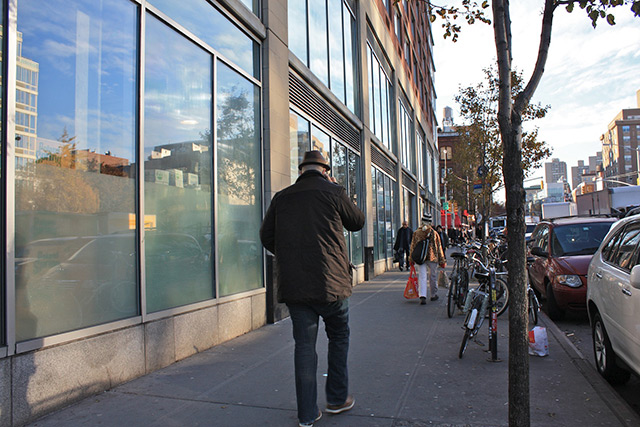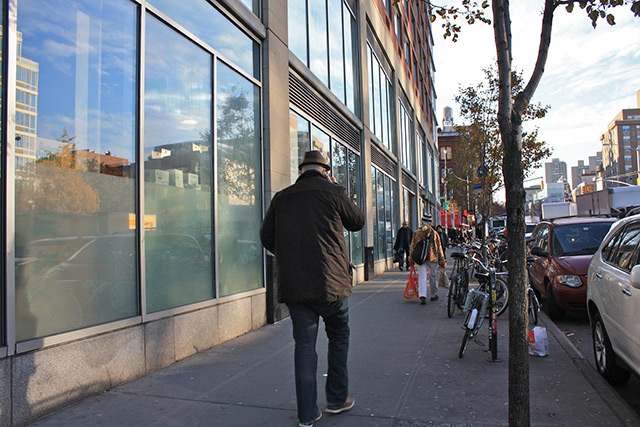
Using urban experiments to find happier streets
Photo: East Houston Street, New York City. People reported feeling significantly happier on this gritty, but active tenement block edge (above) than they did alongside the modern, pristine, but inactive block edge (below). Credit: Charles Montgomery (above) and Alexandra Bolinder-Gibsand (below).
Charles Montgomery is the author of “Happy City: Transforming Our Lives Through Urban Design” and a keynote speaker at “8-80 Cities Forum: The Doable City,” a Knight Foundation-sponsored conference on fostering livable cities happening today through June 18 in Chicago.
Architects and urban designers have long claimed the power to influence human well-being through form and aesthetics. None were so confident as the modernists, whose insistence on functional and aesthetic simplicity changed the course of architectural history. Now that our cities have been transformed by the modern aesthetic, we are discovering that architects are right in their belief in the power of design—but they are frequently wrong in their methods.
Indeed, while researching “Happy City,” I found that our cities influence the ways we feel and behave in ways most of us never realize. It’s time to start paying attention.
Consider East Houston Street, on Manhattan’s Lower East Side. The street is busy—six lanes of jostling New York traffic separate its north and south sides. The south edge offers some wonderful contrasts. Century-old tenements house funky bars, cafes and delis, including the micro-famous Yonah Schimmel’s Knish Bakery. This fine-grained edge is now punctuated by modern glass and concrete buildings with sleek, minimalist facades.
These contrasts make it a great place to do what architects almost never do, which is to actually study the way design makes people feel.
The cognitive psychologist, Colin Ellard, and I, set out to do just that. Working with the BMW Guggenheim Lab in 2011, we created a free tour through the neighborhood. Dr. Ellard fitted tour participants with skin conductance monitors, which measured their excitement as they moved through the streets. He also equipped them with smartphones with an app on which they could record how happy they felt at each stop on the tour.
Not surprisingly, participants were much calmer when protected from the noise and danger of car traffic. They reported being much happier when they were exposed to splashes of nature on the street edge. That wasn’t a surprise either: A huge body of research has confirmed the salubrious effects of nature.

What did surprise us was the effect of architecture. On one stretch of East Houston, the small-lot urban fabric was replaced in 2006 by a Whole Foods store that now presents a nearly unbroken swath of smoked glass for most of the block. Participants reported feeling markedly less happy outside this facade than almost anywhere else. They felt much better once they got to a grittier but lively stretch of shops and restaurants just a block east on Houston. In other words, they reported being happier amid complexity.
Dr. Ellard and I aren’t the first to explore the effect of design on pedestrians. The Danish architect, Jan Gehl, found that when street edges feature uniform facades with hardly any doors, variety or functions, people move past as quickly as possible. But if a street features varied facades, lots of openings and a high density of functions per block, people walk more slowly. They pause more often. People are actually more likely to stop and make cellphone calls in front of lively facades than in front of dead ones. And the slower people move along any street, the more social it becomes.
Street sociability is no trivial matter. Social streets are safer. They are healthier. (Public health researchers have found that older adults actually age more quickly in neighborhoods that lack plentiful doors, windows, porch stoops and destinations, for the simple reason that they are less likely to walk when there are fewer places to reach on foot.) And social streets are great for the economy. Geographers have found that economic growth and creativity correlate directly with a city’s ability to foster face-to-face interactions.
This points to an emerging crisis for urban well-being. As suburban retailers begin to colonize central cities, block after block of bric-a-brac and mom-and-pop-scale buildings and shops are being replaced by blank, cold walls that effectively bleach street edges of conviviality. Even big mixed-use buildings increasingly feature single-use ground floors. The best neighborhoods of some cities are essentially being big-boxed into simplicity.
Luckily, cities have begun to recognize the value of more complex street edges. Melbourne adopted rules banning long, blank facades and forcing new shops and restaurants to have doors or display windows covering at least 80 percent of their frontage. Danish cities have gone further. In the 1980s most large cities in the country actually restricted banks from opening new branches on their main shopping streets. It is not that Danes hate banks; it is that passive bank facades bleed life from the sidewalk, and too many of them can kill a street. It is that the citizenry’s right to a healthy, life-giving public realm has trumped anyone’s right to kill it. New York began playing catch-up in 2012, adopting new zoning that limited the ground-floor width of new stores on major avenues on the Upper West Side.
Cities are not simple. Neither is human well-being. The more we embrace the complexity of both, the healthier, wealthier and happier our cities will become.
Recent Content
-
Community Impactarticle ·
-
Community Impactarticle ·
-
Community Impactarticle ·


